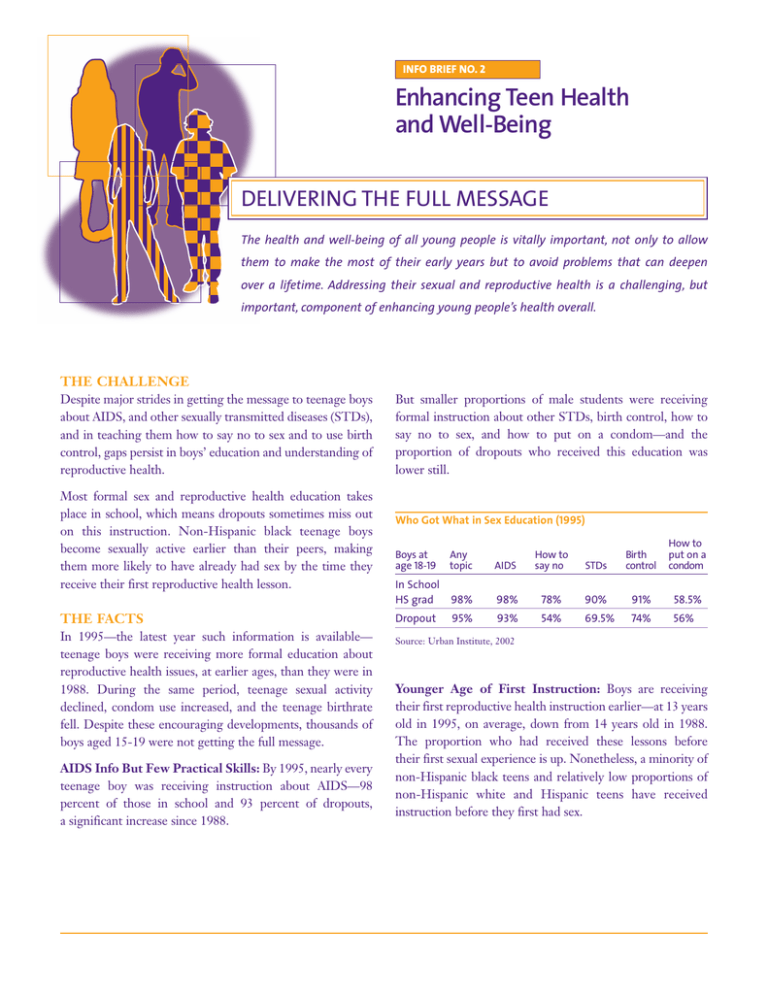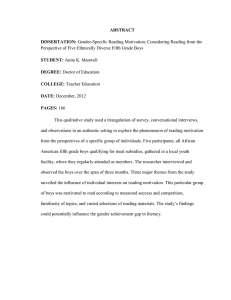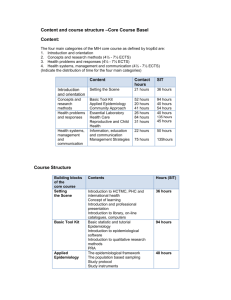Enhancing Teen Health and Well-Being DELIVERING THE FULL MESSAGE
advertisement

INFO BRIEF NO. 2 Enhancing Teen Health and Well-Being DELIVERING THE FULL MESSAGE The health and well-being of all young people is vitally important, not only to allow them to make the most of their early years but to avoid problems that can deepen over a lifetime. Addressing their sexual and reproductive health is a challenging, but important, component of enhancing young people’s health overall. THE CHALLENGE Despite major strides in getting the message to teenage boys about AIDS, and other sexually transmitted diseases (STDs), and in teaching them how to say no to sex and to use birth control, gaps persist in boys’ education and understanding of reproductive health. Most formal sex and reproductive health education takes place in school, which means dropouts sometimes miss out on this instruction. Non-Hispanic black teenage boys become sexually active earlier than their peers, making them more likely to have already had sex by the time they receive their first reproductive health lesson. THE FACTS In 1995—the latest year such information is available— teenage boys were receiving more formal education about reproductive health issues, at earlier ages, than they were in 1988. During the same period, teenage sexual activity declined, condom use increased, and the teenage birthrate fell. Despite these encouraging developments, thousands of boys aged 15-19 were not getting the full message. AIDS Info But Few Practical Skills: By 1995, nearly every teenage boy was receiving instruction about AIDS—98 percent of those in school and 93 percent of dropouts, a significant increase since 1988. But smaller proportions of male students were receiving formal instruction about other STDs, birth control, how to say no to sex, and how to put on a condom—and the proportion of dropouts who received this education was lower still. Who Got What in Sex Education (1995) Boys at age 18-19 Any topic STDs Birth control How to put on a condom 78% 90% 91% 58.5% 54% 69.5% 74% 56% AIDS How to say no In School HS grad 98% 98% Dropout 93% 95% Source: Urban Institute, 2002 Younger Age of First Instruction: Boys are receiving their first reproductive health instruction earlier—at 13 years old in 1995, on average, down from 14 years old in 1988. The proportion who had received these lessons before their first sexual experience is up. Nonetheless, a minority of non-Hispanic black teens and relatively low proportions of non-Hispanic white and Hispanic teens have received instruction before they first had sex. Sex Education Among Males Before First Sex (1995) PERCENT 80 AIDS How to say no 60 Parental Discussions Are Common But Haven’t Increased: Although during the past decade schools expanded their formal reproductive health education, there was little change in the share of teen males who talked with their parents about these topics. In both 1988 and 1995, about three-quarters of teen males interviewed said they talked with their parents about AIDS, other STDs, birth control, or what would happen if they got a girl pregnant. 40 20 0 Non Hispanic black Non Hispanic white Hispanic Source: Urban Institute, 2002 Girls Receive Info Boys Don’t: More teenage girls receive instruction in reproductive health topics than boys. Why isn’t clear. Nine in ten female teenagers report instruction in AIDS, STDs, birth control, and how to say no to sex. Moreover, the majority receive this instruction before they become sexually active. Sex Education Among Females Before First Sex (1995) PERCENT WHAT NEEDS TO BE DONE Efforts are needed to reduce gaps in instruction by race, gender, and school attendance. Prevention efforts should supplement school-based reproductive health education for teenage boys who are in school and reach out to those who are not. Gender-sensitive, accessible sex education programs need to be targeted to teenage boys whether they are in school or not. Age-appropriate instruction should begin earlier, to reach young males before they decide to first have sex. Parents need to increase their communication with their sons and to start these conversations early. Reproductive health interventions need to go where the teenage boys are—especially those out of school. That means delivering these programs at activities involving athletics and team sports, job training and placement services, social clubs and religious organizations. 80 THE DATA Urban Institute researchers analyzed data from the 1988 and 1995 National Surveys of Adolescent Males and compared results about young men with reports by adolescent girls from the 1995 National Survey of Family Growth. 60 40 20 0 AIDS How to say no Birth control Source: Urban Institute, 2002 URBAN INSTITUTE MAY 2002 STDs FURTHER DETAILS Lindberg, Laura Duberstein, Leighton Ku, and Freya L. Sonenstein. 2000. “Adolescents’ Reports of Reproductive Health Education, 1988 and 1995.” Family Planning Perspectives 32(5): 220-226. Sonenstein, Freya L., Kellie Stewart, Laura Duberstein Lindberg, Marta Pernas, and Sean Williams. 1997. Involving Males in Preventing Teen Pregnancy. Urban Institute. For more information contact public affairs at 202.261.5709 or visit our web site at www.urban.org




